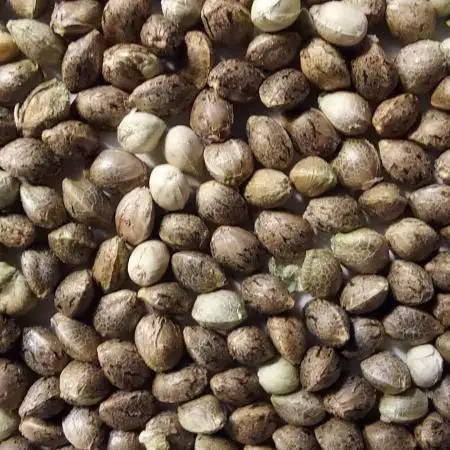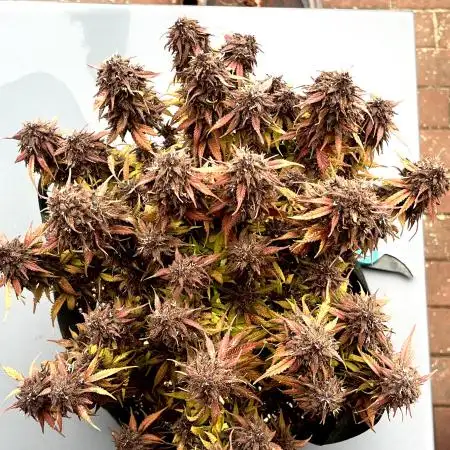The Grow Awards 2026 🏆 













Plants grow slowly and yealds are bad
Kratistosstarted grow question 7mo ago
Hello, I've growinf issues, last run only did 10g for plant, so I decides to go with one auto plant in a 20L pot, after 14 days she haven't developed more than 2 leaves. So I thought It was the old seed and discard It but the new one seems slow too. What am I missing?
Solved
Plant. Other
likes
00110001001001111Oanswered grow question 7mo ago
Stretch is your guide to amping up light intensity. Initially it won't want too much teh fisrt 24-36 horus, but it quickly demands more. This is like riding a bike. You have to learn through trial and error how to steadily increase the light to avoid stretch... while also not giving too much too soon which will also have negative impacts.
Make sure 'some' length of stem does eventually develop between growth nodes. if it ever stays super tight, you know that's a bit too much light.
Local climate and ambient co2 impacts exactly how much light per day a particular plant can handle. A poor VPD will result in less potential photosynthesis per day. So, your garden will almost certainly be different than someone else's garden in this respect. If you both control the climate and other factors in similar ways, you'll have similar 'max' light per day.
Old seeds aren't why somethind grows poorly. If it germinates, it's fine. An old seed may have a higher rate of germination failure, but won't impact the plant after that point.
--------------
Could be any number of reasons for slow growth. So, i'll just hit some basics and point you toward some quality grow guides worth reading over...
The seedling definitely stretched before ths photo was taken, but if you icnreased light since then, don't further overreact until you canobserve how that adjustment impacts growth. If you haven't increased light intensity, do so now for sure, but again... incremental adjustments, observe and re-assess. Take notes when you find a happy zone -- light distance and power. It may take you a couple cycles of seedlings to have a proper method. Don't be too hard on yourself learning new things. Be systematic about it to shorten learning curve. be smart.
Substrate looks to have poor aeration properties. a heavy soil should have 50% perlite or similar (1:1) - this includes what may come with the soil - some low-level algebra can help you calculate how much to add. Coco coir holds less water per volume, therefore only needs about 33% perlite (2:1). In the end both will have similar gas:water mixture per volume and excellent drainage properties that makes overwatering impossible, unless you flood it for 10-15+ minutes, lol. so, don't fall asleep watering, basically. Coco coir has zero advantage i nthis regard despite what commonly gets repeated. Simply a matter of properly amending a soil or coco to achieve similar gas:water mixture per volume.
Also, regardless of what bro science says, potting up does not shock plants. Never seen it and i've done over 400+ 'transplants.' A large pot and small seedling will slow you down. It also makes watering properly a pain in the ass.
1) fully saturate -- this should never cause a problem. when it does it is the fault of how the substrate was constituted.
2) wait for appropriate dryback and repeat.
In soil, usually waiting for 1" deep to dry is a good trigger. You can also use the weight lost as your trigger. If you irrigate at same weight-loss, you need a very similar amount of water each time. Do not whimsically choose to give a volume of water each time. You give enough to get the job done - full saturation with no dry pockets.
This promotes deep roots and proper growth patterns. Not doing so leads to microbial growth on top layers and superficial roots and roots exposed to bone-dry pockets for no reason. the drying pattern is all fucked up if you water superficially.
check out growing guides on cocoforcannabis.com. Even if you use soil, there are numerous parallels and they don't delve into bro-science nonsense. they'll keep you on the right path.
soilless should have 10% runoff in addition to the above 2 steps. Soil should have minimal runoff unless you are trying to dilute the soil due to previous over-feeding mistake. No reason to leach off the amendments in soil that you paid for. the 10% runoff or more for soilless gaurantees you won't have buildup from fertilization over time -- this does not preclude you from overfeeding, of course, but eliminating the chance of buildup is one of the superpowers of soilless growing.
Organomananswered grow question 7mo ago
Forget about growing autos and grow real plants..........photoperiod fems!
You will learn more, get better yields and get actual results that will make your time worth it.
likes
Complain
Ratleanswered grow question 7mo ago
I looked at some of your other diaries, you had some decent harvest. Not sure what your doing so different each time. There's so many opinions and options out there, you need to settle on the basics and stick with one source for a few grows. Pick a soil and fertilizer line for starters. You show custom soil in diary. There's growers on YouTube that do that, and I've considered the move, but do exactly as they do. I've no need to change, why change when I'm already successful with my grows, except to further my harvest weight. The proper equipment can make a big difference, although can be considered expensive but in the long run you save a bundle from having to buy your smoke. I did mine in stages and my set up now cost roughly 0-600. Several of your grows show signs of stress from the get go. Also, they aren't getting very big, especially a couple that are at flower stage. You need to have the basic requirements for her to flourish for you. Proper light and distance, heat and humidity, air flow, watering and food and at correct PH, and a good soil. In my opinion final grow container preferred fabric. Do a check list on basics, if something is off, dial it in. Good luck
likes
Complain
00110001001001111Oanswered grow question 7mo ago
** in the case of a tiny plant and large pot, you have to water differently. water a small circle around the plant but still make sure that water absorbs in all the way to the bottom otherwise you are training superficial roots and increasing risks of root zone issues. Increasae diamter as the tiny plant grows until you can water properly without it remainign sopping wet for extremely long periods of time (no roots, no drinking.. just stagnating water absorbed into those areas, lol)... you dont' want it sopping wet for 10--14+ days lol. Even less than that is probably worrisome
1 like
Complain
RasendeRollo92answered grow question 7mo ago
Hey there !
Just put her closer to the light source.
If you have put her straight into fertilized soil, this could also slow her growth.
Nevertheless considering how she grows (extremely long stem) you definetly have a light issue.
likes
Complain
lolasheranswered grow question 7mo ago
Your plant is looking for light. Looks like she cant find any :-)
likes
Complain
Similar Grow Questions
Solved

MaxGrowCanada
KinkyWhat should I do about this kink?
It appears to be a pinch point.
I intend to scrog. Do I right the stem? Or let it grow 10degrees out? I would like it to be vertical for scrogging, however I do not want to retard growth. Plant is small as it is. Beginning to lignify, do I stop?
Week 4
Plant. Other
6y ago
2
2
Solved

Kenderbetyar
Yellowish leaves/Slow growthThe leaves seem to be a little yellowish,any ideas what could it be? Also,I have noticed that a lot of growers are in the flowering stage ,maybe it's just my impatience but I think they are growing a little slower than normal,perhaps that's because the room temp?
5y ago
2
1
Solved

GrowingGrannie
Move plants out of tent briefly without harm?I, unfortunately, need to move my grow tent to make room for another one since it's overcrowded. If I pump up room temp to something close to what my plants already have, will it bother them to be placed outside the tent for about 30 mins max? 3 in flower, 2 in veg.Plant. Other
4y ago
2
1
Solved

Dillsnills
Runt???Having probs with one plant idk if it's a runt or genetics I'm a first time grower , I have 5 plants but this is the only one that looks like this, any input would help and be greatly appreciated, this is girlscoutcookie I have 2 going posting both to see diff theleavesarewilted
Week 2
Plant. Other
6y ago
4
2
Solved

Didgerydont
More PPM. Yay or nay?Just bought a PPM tester and have noticed that I'm at 500ppm and in the final stages of flowering. These plants are all auto's so I know they are sensitive to nutes. Should I increase the amounts of nutes I'm feeding or is 500 ok until the end?Week 8
Plant. Other
5y ago
2
2
Solved

SneakyDog
Leaf marksI’m looking for advice on the marks on my leaves ?
Leaves. Other
Plant. Other
4y ago
3
3
Solved

blindspot
Can I use 12L pot for feminized ?Can I use 12L pot for feminized ?Buds. Other
Other. General questions
Plant. Other
4y ago
2
Solved

Prilyfe13
Why are my plants different sizes in different tents? They are all the same age. Check diary for details.Why are my 1 gallon plants bigger than the ones in 5 gallon containers?
Same Soil
Same nutrients
Same temp and RH
Same light cycle
Same air circulation
DIFFERENT Lights. 100w vs. 240w (50% power)
DIFFERENT Tents. 2x2x4.5 vs. 3x3x6 Thanks everyone!
2y ago
2
4
Solved

thedoe
remove lower side branches that are stretching outwards to focus on main cola?some of the the lowest growth shoots started to stretch outwards (some stayed short).ideally I would prefer one nice long bud.should I remove them? (maybe 2 or 3 in total)or better to wait until 21 days flowering.
probably should not defoliate for another week right?
thanks!2y ago
6
6


























